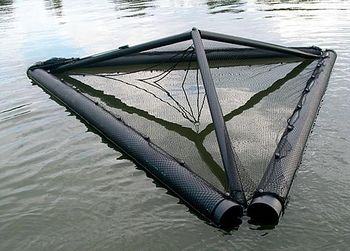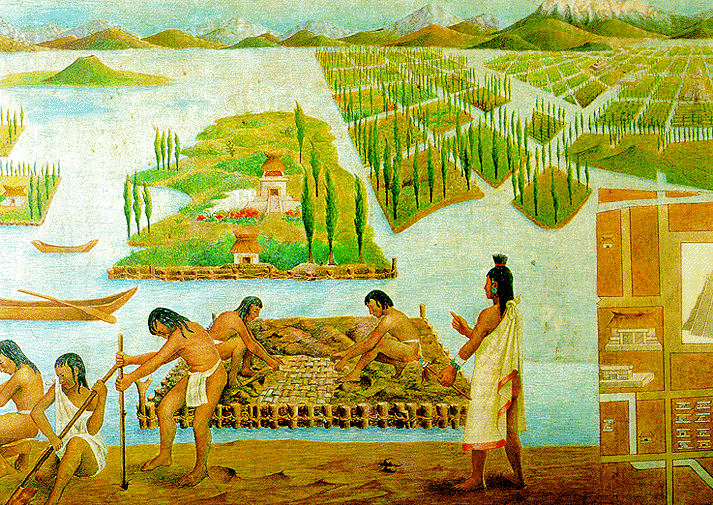Aquaculture
Aquaculture is farming on water. Many of the same principles as farming on land apply, and there can also be synergy between land-based and water-based farming - for example, chickens and ducks will find forage at the edge of the pond. In any system of agriculture based on the interconnections between different organisms, the most productive area will be the edge between two different environments. Therefore, when integrating aquaculture and agriculture it is best to maximize the edge length of the pond; a square pond is a bad idea; one with crinkly edges is much better.
Because fish are cold-blooded, and because water provides buoyancy so they do not have to expend energy to hold themselves up all the time, they are much more energy-efficient organisms than land based animals. Nutrients dissolved in water are more readily absorbed by organisms. For these reasons, aquaculture is 4-20 times more efficient than land-based agriculture in terms of the energy used to make a unit of food and the yield per unit of area. You can, for example, get 12-15kg of food per year from a single taro plant.
Water quality can be controlled to a certain extent by landscape design. Large stones placed in a pond will serve as a heat sink, making the water cooler in hot weather and warmer in cool weather. Growing reeds helps to oxygenate the water. Freshwater reeds grow much faster than any land-based plants can, so make a good source of feed for herbivorous animals. Algae often forms the bottom of the food chain in an aquaculture system and goes on to be converted into larger edible organisms. Therefore, an area of still water with tree stumps where algae will grow can be advantageous.
See also aquaponics, a more controlled method of growing fish, and algae farming.
Chinampa farming
Chimpanas were a highly productive means of agriculture developed by the Aztec civilization. They possibly hold the title of the highest-yielding kind of traditional agriculture. They have since been adopted by the permaculture movement.
They consist of a series of alternating canals and narrow artificial islands. This gives you a lot of different areas with different yields -
- The land - this can grow vegetables, trees, chickens etc.
- The surface of the water - this can grow ducks, floating plants such as lotus
- The middle of the water - this can grow fish and aquatic plants
- The bottom of the water - this can grow prawns, catfish etc.
- The edge between the water and the land - this can grow reeds, taro, typha (as chicken feed) etc.
- A trellis above the water - this can grow vine-plants such as grapes, strawberries etc. while shading the water.
These different areas also synergize with each other. The vines drop nutrients into the water. The water provides nutrient for reed crops which feed land-based animals. The ecosystem can become extremely complex, with thousands of useful synergies.
Aztec chinampas were intermittently fertilized with compost and with mud dredged from the bottom of the lake. The water flowing around the island creates a microclimate in which extremes of temperature are mitigated.
Chinampas nowadays usually have canals about 1.5m deep. The Aztecs used major canals (acalotes) which were 5m wide and 1.5-4m deep, plus minor canals (apantles) which were 1-3m wide and 1m deep.
- http://www.plu.edu/~mayac/building-chinampa/home.html - Good info on building methods
- http://www.chinampas.info/ - A site maintained by a guy who has done PhD research on chinampas
- http://www.apms.org/japm/vol17/v17p74.pdf
Video: Sepp Holzer's permaculture - Aquaculture: Synergy of Land and Water
Open-source fish farm

Open-source oyster gardening
Oysters provide a food source in addition to substantial environmental benefits, such as filtering water and providing a marine habitat for smaller fish and organisms. Permits may be required depending on locality.
- TOGA: The Tidewater Oyster Gardeners Association provides information on getting starter in oyster gardening including build plans.
- Taylor Float Plans: a Taylor Float is one example of "rafts" used to grow oysters from spat (oyster "seed").
- Wikipedia: Oyster farming
Other resources
- Bill Mollison, 15 hour audio lecure series on aquaculture
- Permaculture: A Designer's Manual by Bill Mollison. Contains a chapter on aquaculture.
- Information About Sustainable Seafood
- A Video by the YouTube Channel "Andrew Millison" Titled "Chinampas of Mexico: Most Productive Agriculture EVER?" (Clickbaitey Title, but good mini-documentary) (~18 Minute Watch)
